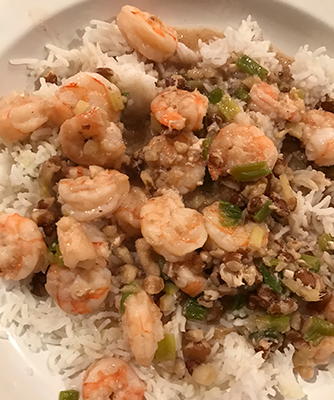Yummy Black Walnut Shrimp
Published 3:25 am Saturday, February 24, 2018
We have some black walnut trees here on the farm planted by a previous owner and my husband decided to harvest some this year. The pecan trees had a bad year. He picked a lot of walnuts and put them in the driveway. It is a good way to hull them without so much work. Run the car over them and later pick them up sans hulls. That is where you can get your hands stained. Cure them in a cool dark place for a couple weeks. Then comes the hard work. The shells are quite hard! You need a hammer to crack, and then picking out the meat you need a nut hook and more time. No wonder these nuts command a high price in the store. One source says storing the hulled walnuts for a couple months makes the nut meat shrink some and therefore easier to get out. If you are not going to use the walnuts soon they can be stored in the freezer.
My mother used them in cakes but we are more into savory than sweets. I looked through my many cookbooks but didn’t find any recipes even for sweets. Rosalind Creasy did write about them in her book, The Gardener’s Handbook of Edible Plants. She talks about the black walnut, Juglans nigra, which we grow. Most people like and eat the more familiar Persian (or English) walnut, J. regia. She mentions two more: butternut, J. cinerea and California black walnut, J. Hindsii.
She says black walnuts, like okra, gooseberries, and rhubarb are an acquired taste. Their flavor is quite strong and distinct. I like it and use it in my salads. It adds an extra flavor in a fruit cake.
I wonder why they do not appear more in Southern cooking as they would be available to the harvester for free, like other wild foods. Certainly the wood was used in Southern furniture.
If you choose to plant, the trees are nice for shade, but are not for small tailored yards. Ours grow in the pastures. Also of note, the roots exude an acid that inhibits the growth of many plants. Keep them away from vegetable gardens, flower beds, azaleas. They can be grown even as far north as Ontario and south to northern Florida and are native to the eastern US. Although the deep South is not part of their natural range, they certainly grow well here is south Mississippi.
They have omega-3 fatty acids and are heart healthy and are rich in antioxidants. They also have antifungal properties.
I did find a savory recipe for black walnuts and shrimp. It is basically a stir fry but instead of peanuts or cashews, black walnuts are used instead.
Black Walnut Shrimp
Serves 4
1 pound medium shrimp, peeled and deveined
Coating: 1 egg white, 1 teaspoon salt, 2 teaspoons cornstarch
½ cup peanut oil
2 teaspoons fresh chopped ginger
2 tablespoons chopped green onions
½ cup black walnuts
½ teaspoon salt
1 tablespoon Hoisin sauce
1 tablespoon rice wine or white vinegar
½ cup vegetable or chicken stock
½ teaspoon cornstarch and ½ tablespoon water mixed together as a thickening agent
1 teaspoon sesame oil
Lime wedges
Place shrimp into coating items in a bowl and mix. Refrigerate 20 minutes.
Heat wok or iron skillet until hot and then add peanut oil. Heat to warm, not smoking. Add shrimp, stir well and turn off heat. Allow shrimp to sit in warm oil for 2 minutes. Drain and place in stainless steel bowl.
Wipe pan clean and return 1 ½ tablespoon of drained oil back in. Add ginger and onions. Stir fry 30 seconds. Add walnut and fry for 30 seconds. Return shrimp to pan with all other ingredients and stir fry for 2 minutes.
Place the meal on a platter and serve with rice or noodles with lime wedges.






